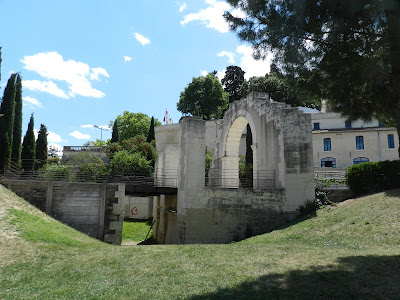A couple of months ago, a guy came into the (now-departed) English Corner Shop and announced he was leaving town. He'd been a regular customer, and was saying good-bye. "Yeah, they've covered up the dig and now the tram-line's going in." As it developed, he was an urban archaeologist from England who'd been part of the team excavating by the Babotte before the tram dug the area up. "We found a lot of information about where the roads had previously been," he told me, "and some information about what went on in the neighborhood there, such as what kinds of trades had been practiced and so on. No sexy artifacts, I'm afraid, but the town's learned a lot about its history, which is what they pay us for."
At that point, I remembered that there was a "parc archéologique" on the other side of town from the Corner Shop, and, although I'd walked through it a few times, I'd never stopped to figure out just what had been excavated, although I knew that the tram-station excavations for the Corum stop in 1999 had unearthed it all. So today, realizing that I was missing the historical journeys with E and J while E's leg healed (he was getting muscle cramps which made it difficult to drive), there was a hunk of local history just down the street that I could easily take a look at.
Actually, there was a lot of stuff. The most important to the history of the town itself was the Porte du Pila St. Gely, built between the 14th and 15th centuries, which was one of the most important gates to what was then a walled city.
This is a reconstruction, but you can see the wooden drawbridge. The roads from Nimes converged nearby, and this was the checkpoint you had to pass to get into the city. The gate itself had two paths, one for wide vehicles like carts, the other for pedestrians, which you can sort of see here.
I was actually trying to get the foundation there, but that's the wide track over across from the narrow track, where I was shooting from.
Here it is from the other side, once you're in.
That's the Corum, the opera-house/convention center in the background.
And, once you were in, you could rest at the Hospital of the Holy Spirit, established by Gui de Montpellier in the 12th century.
Gui (1168-1208) was probably the brother of the local ruler, Guilhem VIII (1156-1202), whose palace stood near where the Palais de Justice is now, over by the Peyroux. Gui, for his part, wasn't ever going to be the big cheese, so, as younger brothers did in those days, he became a monk and founded the Order of the Holy Spirit, and went to Rome to lobby for its recognition by the Vatican. He succeeded, and this hospital was an important stop on the pilgrimage to Compostella in Spain. Like all the hospitals along that route, it had a medical function, of course, but was also a place of rest, and the brothers of the Holy Spirit presumably could take care of spiritual matters for you. It was one of several in town, but the only one which has a bit of it surviving: above shows the rough outline of its chapel, another thing the tram excavations uncovered.
Outside the city walls was where the dangerous stuff took place. Montpellier was famous for its pottery for a long time, and in fact there's an exhibition dealing with that at both the Musée Fabre and the museum down at Lattera at the moment, for those who are interested -- and you can now get to the latter by tram. Excavation for the tram came up with the foundations of four pottery kilns, and they're right at the foot of the stairs leading from the Esplanade.
That's three of 'em; not sure where the other one is. On display behind filthy windows on the handicapped elevator's shaft are some pieces of local pottery. They didn't photograph too well, but this one's an excellent example:
Across the tracks is something I'd looked at forever without realizing that it was more than a neat illusion. Here it is from the Esplanade.
And from across the street.
It's a piece by an artist named Betka Siruckova called "The Carnival of the Animals," and as such is a nice play on words: it stands at the entrance to the Beaux Arts neighborhood, so called because it's where the École des Beaux Arts is. But it wasn't always called that: this was the slaughterhouse district, and Siruckova's paying homage to the various kinds of animals slaughtered there as well as punning on the word "carnival," which comes from the Latin carne vale, "farewell to meat," which is what the carnivals of the days before Lent are all about. At any rate, it must have been a good place for the slaughterhouses, because the stream called the Verdanson passes in front of this building, and it was easy enough to build sewers in the middle of the street and let the offal and blood drain into it.
There's surprisingly little history here organized as well as this particular little spot, and a lot of it needs interpretation that the locals aren't providing. Just the other day, a reader made a wonderful comment on an old post I totally blew (read the comments and you'll see what I mean, although I do want to thank Olivier for his diplomacy!) which alerted me to the fact that the medical school here was largely run by Protestants, something I'm going to have to chase down now.
Not that I don't want to get out in the countryside and clamber around looking for Romans and ruined monasteries and all, but sometimes this stuff really is right in your back yard.
Lady Carcas
9 years ago









No comments:
Post a Comment